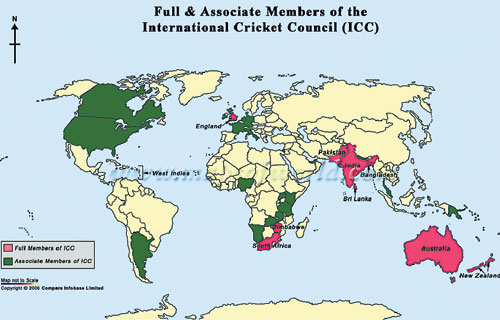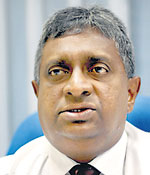 |
Unlike all the other major sports which have taken deep root in the modern world, Test cricket is the most time consuming team sport where twenty two people have to test their wits for five consecutive days and yet may not arrive at a definite result. But, yet for the past one hundred and sixty-five years or more this game conceptualized by the English and spread by their marauding imperialism has stayed on with some of its colonies and has come to be loved by its citizenry like a make of their own.
Today though the game is spread over 37 countries with ten members with full status, the game is facing its real Test in the battle for survival or is it so? But, there is one definition; the game is at crossroads since its near debacle with the channel-nine issue in the late nineteen seventies.
As long as the game survived on its own it developed. But, within the past three decades with cricket taking its first division to a shorter version of the game and then closely hounded by the television conglomerates, it has become commercial oriented with a bigger accent on speed rather than the imbedded technicalities which has made the game so special and different to the others. Ironically cascading down the line now it almost has reached its limit by surrendering itself to the T20 version of it.
Since its advent the debacle has hastened. From one corner of the globe former Australian rebel Shane Warne calls for the scrapping of the limited overs version of the game. Then in another turn the Indian maestro Sachin Tendulkar talks of a 25 x 4 ODI concept. Closely following the head of the Cricket Players consortium Tim Lamb talks of a concept of Test playing nations torn into two pieces and Tests played only among the haves and have-nots. But, how he arrived upon that equation is one of the greatest mysteries in the modern day reasoning. However one thing is sure – it is not the Duckworth and Lewis system.

Burdened by this hullabaloo Musing sought the opinion of former Sri Lanka skipper Duleep Mendis -- the Chief Executive Officer of SLC has been Sri Lanka’s voice at the ICC for over half a decade. Mendis who has involved himself in the game of cricket in every possible capacity of the game (May be the only one in the game’s history) and to our mind is the most competent person to explain the present status quo in cricket’s predicament.
Mendis explained: “Test cricket is number one and it will remain so in the years to come, because it has been the tradition and the epitome in cricket. True there have been cries about the disintegration of Test cricket, but, it has happened in only certain countries, but if you take it as a norm, Test cricket is well patronized in most of the countries.
“Of course there were some modifications that they discussed as an incentive to the dwindling crowds. One was that if we could play Test cricket day night. The idea was that at that time people would be free and they could drive down to the ground and watch the match after work. But, here again you are at the same junction. You watch the game on the first day, the next day you have to go to work and that thought is not going to work that favourably with the general public and you are back to zero. All in all if this change occurs Test cricket will be different. As far as I am concerned men in white playing with a red leather ball is the purest form of the game and it should not change”.
Mendis explained that in the last half of the nineteen sixties there were certain concerns about the viability of Test cricket and in a bid to save the day, one-day cricket was introduced and that was followed by the Prudential World Cup in the early seventies and in real there was a revival in the game. “Initially limited overs were played for sixty overs, but once they felt it went for too long it was reduced to fifty overs and there it stayed”. Duleep quipped.
 |
| Dulip Mendis |
Then to add more diversity and excitement to the game, the authorities introduced the coloured clothing and the white ball and the dark site-screen. With the introduction of all these effects the shorter version of the game has become more exiting and the SLC CEO feels it has got more than established and needs no further adjustments.
Mendis added “Then with the introduction of day-night cricket the cricketers found out it had it its own advantages and disadvantages. One of the biggest problems was the disparities of the wickets on either side of the lights that the cricketers found at some venues. As a result this new concept of 25 x 4 had come where each team gets a chance of batting during the day light and also in the night. However it is a concept, which has to be discussed and agreed upon in the future, even if it is agreed upon it also has to be tested and seen if it is viable”. However Duleep agreed that this is also a kind of an extension to T20 cricket and once again the technical aspects of cricket would come to surface.
Duleep Mendis still feels that the 50 x 50 still holds its charms. The biggest threat to it has come in the form of the T20 version of cricket. Duleep says the T20 has its own advantages. “It begins in the evening, within a very short period of time you have arrived upon a result. However, as far as I am concerned T20 is essentially a spectator game rather than a game for cricketers. It was introduced mainly for entertainment and not for a proper game of cricket and the technicalities that is involved with the established version of the game. I also must admit it also introduced some new aspects – the cricketers were financially benefited. They have found new horizons in the game. In addition to that in the real game it has brought new heights in fielding endurance, ways of scoring and the scoring rates. Now even in a normal ODI the scoring rates are faster that it used to be. At the same time even bowlers are getting used to bowl tighter lengths and stick to narrow avenues.
In conclusion Mendis explained that now there are three forms of cricket that are established and all three versions have their own values. Now the onus will be on the respective administrators to see how they could preserve these three forms of the game without giving prominence to one form of the game over the other.
Right now cricket has it full quota of entertainment. Test Cricket for the connoisseur, one day internationals for the excitement of the more established version and the T20 which is mainly a product for entertainment. |



